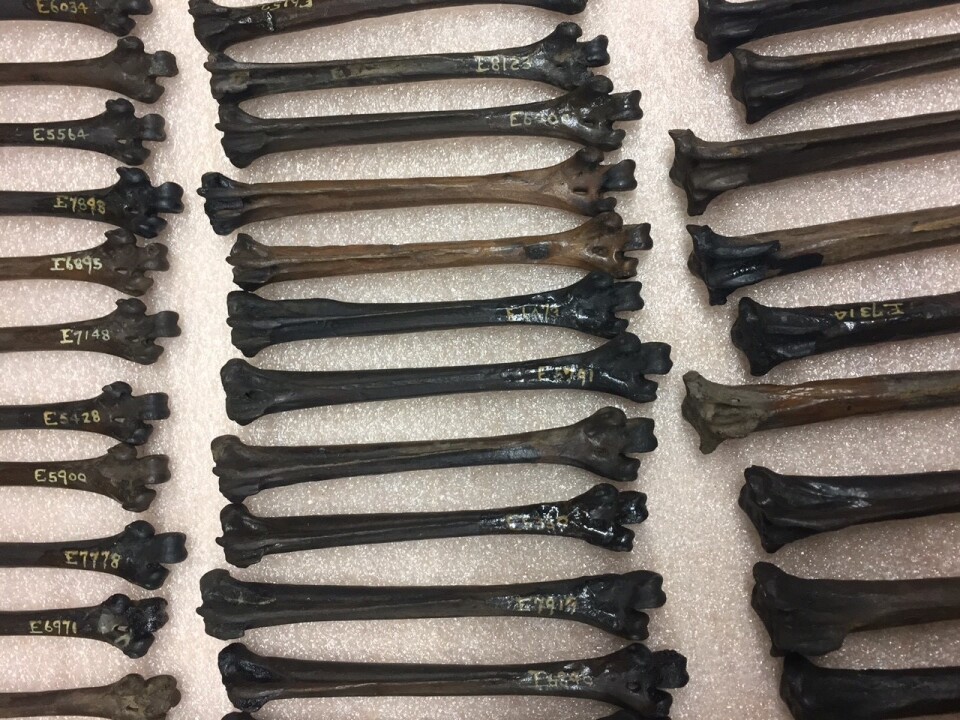With our free press under threat and federal funding for public media gone, your support matters more than ever. Help keep the LAist newsroom strong, become a monthly member or increase your support today.
From Pleistocene tar pits to public nuisance: the history of California's turkeys
California has a complicated relationship with turkeys. The turkeys that walk brazenly down our streets and grace our Thanksgiving tables are not native to the state. But today's wild turkey has a long-extinct prehistoric relative that lived exclusively in Southern California. We know this because scientists are digging its bones out of the hardened asphalt at the La Brea Tar Pits in Los Angeles -- a geologic seep that's been oozing natural asphalt for millennia. So in a week when 46 million turkeys are sacrificed for our Thanksgiving tables , I took a trip to the tar pits to pay my respects.
Meleagris californica, Southern California's prehistoric turkey was slightly smaller but otherwise indistinguishable from today's wild turkey. Behind a glass exhibit at the Tar Pits museum, a skeleton stands surrounded by other, nobler birds that have been also pulled out of the tar and reconstructed: eagles, condors. Their bones are stained black from thousands of years in the tar.

Turkey bones are the second most common kind of bird bone that researchers excavate from the tar pits. Many of them died here, more than 10,000 years ago, after their feet got stuck in the watery, goopy tar. Being gregarious birds that travel in flocks, they would call out to other turkeys for help, and those would get stuck too, said Ken Campbell, a turkey expert at the Natural History Museum of LA County. Then golden eagles would feast on the trapped turkeys. Indeed, the eagles are the most common type of bird found in the tar.
California's prehistoric turkeys went extinct, along with many other animals, at the end of the Pleistocene era. Scientists think climate change and hunting by humans were to blame.
Until 1877, there were no turkeys in California. That’s when a couple of ranchers introduced them to Santa Cruz island as game birds, according to Scott Gardner with the California Department of Fish and Wildlife. But their population didn’t really take off until Gardner’s own agency got involved in the early 20th century. The Department of Fish and Game, as it was known back then, began capturing turkeys in other states and releasing them in California, so people could hunt them. The turkeys spread quickly throughout the coastal range and into the foothills of the Sierra Nevada.

“That’s kind of the irony,” Gardner said. “California has tremendous turkey habitat. With our combination of oak woodlands and pine trees, it’s just high quality turkey habitat.”
Turkeys now live in about a quarter of the state. And Gardner now seems a bit embarrassed about his agency’s role in helping them spread.
“Yeah, full disclosure, it was the Department of Fish and Game," he said. "I would emphasize that there was probably not much opposition to that. People were probably pretty supportive of that at the time it was occurring."
By 2004, the department stopped releasing wild turkeys in the state. And in some places, like the city of Davis, turkeys have become a nuisance. There, aggressive turkeys stalk shoppers downtown and bully people paying their respects at cemeteries. Sometimes they even corner people or trap them in their cars, leading to a slew of embarrassing 911 calls. Davis now kills aggressive turkeys and is trying to keep the local population from growing.
Gardner says negative human-turkey interactions often follow a similar pattern that can easily be broken if people change their behavior.
“It often starts with people really wanting them around, wanting to see more of them, and starting feeding them. Shortly thereafter, it starts to become a nuisance,” he said. “In general with wildlife, you need to appreciate them from a distance. You need to keep them wild.”










